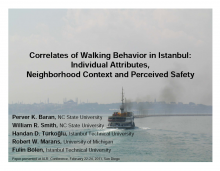We are pleased to announce an exciting new alliance between Active Living Research and GP RED to co-host and coordinate...
Correlates of Walking Behavior in Istanbul: Individual Attributes, Neighborhood Context and Perceived Safety

Presentation at the 2011 Active Living Research Annual Conference
Background:
Research recognizes that built and social environments are likely to act together to influence walking behavior and physical activity. Of the many social environment characteristics that could be relevant to physical activity, built environment researchers have been most interested in crime safety. However, the extant research evidence does not suggest consistent relationships between crime and physical activity. Additional research evidence is needed to show how safety concerns are associated with neighborhood based walking behavior. In addition, in order to develop effective interventions research evidence from different countries is needed.
Objectives:
The objective of this study was to understand relationships among perceived crime safety, neighborhood social networks, micro-ecological characteristics and walking behavior, while controlling for multiple individual and contextual variables in Metropolitan Istanbul, Turkey.
Methods:
Data were obtained from the Measuring of the Quality of Urban Life in Istanbul study. The sample consisted of 2484 residents of metro Istanbul. The face-to-face interviews were administered between November 2005 and February 2006 and took place in respondents’ homes. A three-stage cluster sampling strategy was adapted to select cluster beginning points, housing units, and respondents.
Study analysis, included two dependent variables, utilitarian and recreational walking. Utilitarian walking referred to having walked to visit a friend or shop in the past week, while recreational walking referred to having walked to a playground/park or walked to exercise in the past week. Individual-level variables included gender, age, education, being retired, household income, and Body Mass Index (BMI). Perceived safety was measured by an index of neighborhood safety (Cronbach’s alpha .818). Neighborhood social interaction was measured with an index of perception of how much social interaction there is among neighbors (Cronbach’s alpha .728).
Micro-ecological level variables included respondents’ ratings of eight attributes of the micro environment defined as what one sees from one’s front door and included: a) the busy places index (Cronbach’s alpha = .774), b) the physical disorder index (Cronbach’s alpha = .791), and the social disorder index (Cronbach’s alpha= .731). A number of “control variables” were included which characterized some additional neighborhood context variables, the respondent’s household, and respondent’s satisfaction with a number or dimensions of living in a neighborhood. Multinomial logistic regression model was used to address the question of which variables increase or decrease the odds that someone will engage in utilitarian or recreational walking.
Results:
Overall, 1635 valid interviews were obtained. About 64% of the sample stated they have walked to visit a friend in the past week and 78.3% haved walked to shop in the past week (56.3% have done both). Only 21.5% walked to a park or playground in the past week and 21.1% walked to exercise (only 10.2% have done both in the past week).
Among individual characteristics, gender (females) (OR=1.52, p<0.01), education (OR=1.22, p<.05), and being retired (OR=2.76, p<0.001) significantly increased odds of engaging in utilitarian walking behavior. However, age (OR=.98, p<0.01) and household income (OR=.86, p<0.001) were associated with lower odds of engaging in utilitarian walking. There was no association between respondent’s BMI and utilitarian walking. Among the contextual-level attributes, perceptions of safety (OR=1.35, p<0.01) and neighborhood social networks (OR=1.74, p<0.001) were associated with increased odds of engaging in utilitarian walking. Concerning the micro-level neighborhood attributes, busy places supported utilitarian walking (OR=1.18, p<0.01), whereas physical disorder (OR=.89, p<0.5) discouraged it.
Regarding recreational walking, the results showed that education (OR=1.53, p<.001) significantly increased the odds of engaging in recreational walking, while being retired (OR=.39, p<.001) decreased the odds. There was no association between age, gender, and BMI and recreational walking. Perceived neighborhood safety (OR=1.22, p<.0.5) and busy places (OR=1.09, p<.05) increased the odds of engaging only in one type of recreational walking, but not in both. Physical disorder (OR=.83, p<0.01) was associated with lower odds of engaging in recreational walking. Social networks and social disorder were not associated with recreational walking.
Conclusions:
Perceived neighborhood safety and physical disorder in the immediate context were important determinants of utilitarian and recreational walking. In addition, busy places and an assessment of the area as a good place to walk encouraged both types of walking. The differences between the factors influencing the two types of walking behavior related to a number of individual attributes and neighborhood social networks, neighborhood density, number of cars in the household, and the overall satisfaction with living in the area. Clearly, walking behavior is not uni-dimensional, as utilitarian and recreational forms of walking seem associated quite differently with individual, social, and contextual attributes. The results of the analyses are promising for further development of models to help understand walking behavior and for informing neighborhood planning and design.
Support:
This study was funded by the Strategic Planning Unit at the Greater Istanbul Municipality and Istanbul Technical University Research Foundation; Research conducted at: Istanbul Technical University and NC State University.
STAY UP TO DATE
RECENTLY ADDED TOOLS & RESOURCES
MOVE! A BLOG ABOUT ACTIVE LIVING
The "Active Living Conference" aims to break down research and practice silos and...







